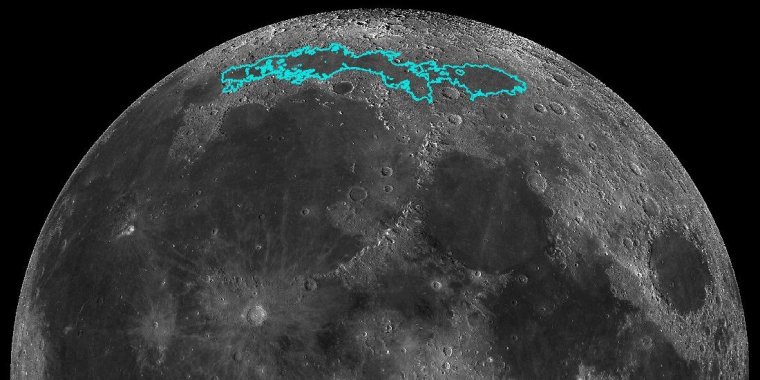| News / Space News |
Study Finds New Wrinkles on Earth's Moon
Billions of years ago, Earth's Moon formed vast basins called "mare" (pronounced MAR-ay). Scientists have long assumed these basins were dead, still places where the last geologic activity occurred long before dinosaurs roamed Earth.

New surface features of the Moon have been discovered in a region called Mare Frigoris, outlined here in teal. Photo: NASA
But a survey of more than 12,000 images reveals that at least one lunar mare has been cracking and shifting as much as other parts of the Moon - and may even be doing so today. The study adds to a growing understanding that the Moon is an actively changing world.
Taken by NASA's Lunar Reconnaissance Orbiter Camera (LROC), the images reveal "wrinkle ridges" - curved hills and shallow trenches created by a lunar surface that is contracting as the Moon loses heat and shrinks.
Previous research has found similar surface features in the Moon's highlands, but wrinkle ridges have never been seen in basins before now. For this study, researchers focused on a region near the Moon's north pole called Mare Frigoris, or the Cold Sea.
The study estimates that some of the ridges emerged in the last billion years, while others may be no older than 40 million years old. That's relatively fresh in geologic terms; previous studies have estimated these basins all stopped contracting about 1.2 billion years ago.
Both Earth and its Moon experience what's known as tectonics, processes that push up mountains, rip apart land masses and create quakes. On Earth, these processes occur constantly as the planet's mantle causes pieces of crust, called plates, to shift against one another.
The Moon doesn't have tectonic plates; instead, its tectonic action occurs as the Moon slowly loses heat from when it was formed nearly 4.5 billion years ago. The heat loss causes its interior to shrink, crinkling the surface and creating distinctive features like those identified in the study.
The Moon's tectonic action is especially visible in Mare Frigoris.
As the ground under Mare Frigoris shifts, it pushes up wrinkle ridges, which typically snake along the ground for several miles. The longest ones stretch about 250 miles (400 kilometers) - and rise as much as 1,000 feet (333 meters). Tectonic pushing and pulling of the lunar crust also sculpt curved hills called lobate scarps and shallow trenches known as graben. (NASA)
YOU MAY ALSO LIKE


